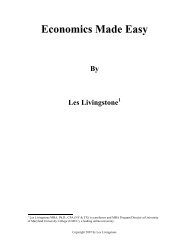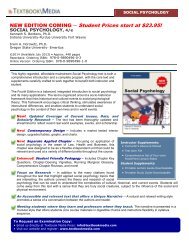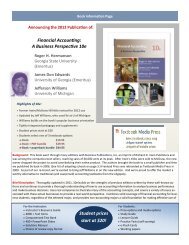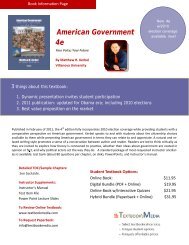Book Information / Sample Chapter(s) (PDF) - Textbook Media
Book Information / Sample Chapter(s) (PDF) - Textbook Media
Book Information / Sample Chapter(s) (PDF) - Textbook Media
You also want an ePaper? Increase the reach of your titles
YUMPU automatically turns print PDFs into web optimized ePapers that Google loves.
<strong>Chapter</strong> 4 Demand and Supply<br />
75<br />
What’s a Price Bubble A Story of Housing Prices<br />
According to data from the Federal Housing Finance<br />
Agency, the average price of a U.S. single-family home<br />
rose about 1–3% per year in the first half of the 1990s;<br />
3–5% per year in the second half of the 1990s; 7–8% per<br />
year in the early 2000s; and more than 10% per year from<br />
late 2004 to early 2006.<br />
Although no one seriously expected price increases<br />
of 10% per year to continue for long, what happened next<br />
was still a shock. Although certain metropolitan areas or<br />
states had seen declines in housing prices from time to<br />
time, there had not been a nationwide decline in housing<br />
prices since the Great Depression of the 1930s. But housing<br />
prices started falling in 2006, and through much of 2008<br />
and 2009, housing prices were falling at a rate of 4–5%<br />
per year. Of course, these national averages understate<br />
the experience of certain parts of the country where both<br />
the boom and the bust were much larger.<br />
Economists refer to this chain of events as a price<br />
“bubble.” Remember that one possible reason for demand<br />
to shift is expectations about the future. If many people<br />
expect that housing prices are going to rise in the future,<br />
demand for housing will shift to the right—thus helping<br />
the prediction of higher prices come true. For a time, a<br />
cycle of expecting higher prices, increases in demand,<br />
and resulting higher prices can be self-reinforcing. But this<br />
process cannot last forever. At some unpredictable time,<br />
many people recognize that the expectations of ever-higher<br />
future prices are unrealistic, at which point demand shifts<br />
back in the other direction and the price bubble deflates.<br />
Price bubbles are not just observed in housing: they are<br />
also seen from time in markets for collectible items, and<br />
in stock markets.<br />
The bursting of the price bubble in housing—which<br />
happened in many countries around the world, not just<br />
the United States—has caused great economic difficulties.<br />
Those who owned homes watched the value of this asset<br />
decline. Some of those who borrowed money to buy a<br />
house near the peak of the bubble found a few years later,<br />
after the bubble had burst, that what they owed to the bank<br />
was much more than the house was worth. When many<br />
people began to default on their mortgage loans, banks<br />
and other financial institutions then faced huge losses. The<br />
bursting of the price bubble in housing helped to trigger the<br />
global economic slowdown that started in 2008.<br />
shows how people and firms will react to the incentives provided by these laws to control<br />
prices, in ways that will often lead to undesirable costs and consequences. Alternative<br />
policy tools can often achieve the desired goals of price control laws, while avoiding<br />
at least some of the costs and trade-offs of such laws.<br />
Price Ceilings<br />
Price controls are laws that the government enacts to regulate prices. Price controls<br />
come in two flavors. A price ceiling keeps a price from rising above a certain level,<br />
while a price floor keeps a price from falling below a certain level. This section uses<br />
the demand and supply framework to analyze price ceilings; the next section turns to<br />
price floors.<br />
In many markets for goods and services, demanders outnumber suppliers. There<br />
are more people who buy bread than companies that make bread; more people who rent<br />
apartments than landlords; more people who purchase prescription drugs than companies<br />
that manufacture such drugs; more people who buy gasoline than companies that refine<br />
and sell gasoline. Consumers, who are also potential voters, sometimes unite behind a<br />
political proposal to hold down a certain price. In some cities, for example, renters have<br />
pressed political leaders to pass rent control laws, a form of price ceiling that usually<br />
works by stating that rents can only be raised by a certain maximum percentage each year.<br />
Rent control can become a politically hot topic when rents begin to rise rapidly.<br />
Rents might rise for many reasons. Perhaps a change in tastes makes a certain suburb<br />
or town a more popular place to live. Perhaps locally based businesses expand, bringing<br />
higher incomes and more people into the area. Changes of this sort can cause a change<br />
in the demand for rental housing, as illustrated in Exhibit 4-10. The original equilibrium<br />
E 0<br />
lies at the intersection of supply curve S 0<br />
and demand curve D 0<br />
, corresponding to an<br />
price controls: Government<br />
laws to regulate prices.<br />
price ceiling: A law that<br />
prevents a price from rising<br />
above a certain level.<br />
price floor: A law that<br />
prevents a price from falling<br />
below a certain level.













